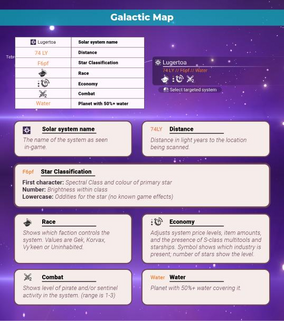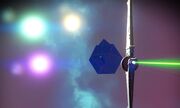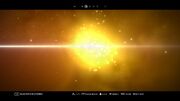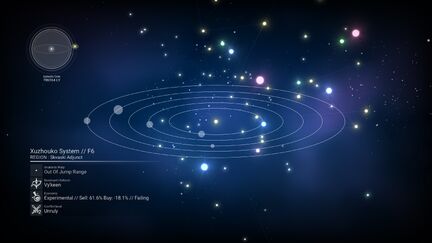Thamalandis (talk | contribs) m (→Classification) |
SpaceExplorerNMS (talk | contribs) No edit summary |
||
| (46 intermediate revisions by 14 users not shown) | |||
| Line 1: | Line 1: | ||
| − | {{Version| |
+ | {{Version|Origins}} |
| − | [[File:NMS1dot3starsystemview.jpg|right| |
+ | [[File:NMS1dot3starsystemview.jpg|right|432x432px]] |
A '''star system''' is a system of [[planet]]s and other objects that orbit a [[star]]. |
A '''star system''' is a system of [[planet]]s and other objects that orbit a [[star]]. |
||
==Summary== |
==Summary== |
||
| − | These [[procedural generation|procedurally generated]] systems are the seat of all planets and worlds in the game. Most of the planetary systems in [[No Man's Sky]] will |
+ | These [[procedural generation|procedurally generated]] systems are the seat of all planets and worlds in the game. Most of the planetary systems in [[No Man's Sky]] will never be visited. |
They are also known as '''solar systems''' or '''planetary systems'''. |
They are also known as '''solar systems''' or '''planetary systems'''. |
||
==Information on Galaxy Map== |
==Information on Galaxy Map== |
||
| + | [[File:galactic_Map-01.png|thumb|322x322px|alt=Galaxy Map Explanation from NMSResources]] |
||
| − | + | The UI for the [[Galactic Map]] shows key information regarding the system selected. The Information that is displayed is: |
|
| + | * Star system name |
||
* [[Spectral class]] |
* [[Spectral class]] |
||
| + | * Presence of planets with seas or oceans ('''WATER''') |
||
| − | * Distance |
||
| + | * The [[region]] the system ID is part of |
||
| + | * Distance from the [[Galaxy Centre]] |
||
* [[Faction|Dominant Lifeform]] |
* [[Faction|Dominant Lifeform]] |
||
* [[Economy]] (Requires [[Economy Scanner]] ) |
* [[Economy]] (Requires [[Economy Scanner]] ) |
||
* [[Conflict Level]] (Requires [[Conflict Scanner]] ) |
* [[Conflict Level]] (Requires [[Conflict Scanner]] ) |
||
| − | |||
| − | <sub> Note: [[Update 1.38]] restored [[Spectral class]] to the [[Galactic Map]]. |
||
==Classification== |
==Classification== |
||
| − | There are four [[System |
+ | There are four [[System colours|colours]] of star systems. |
* Yellow star systems (Class F & G) are the most common. |
* Yellow star systems (Class F & G) are the most common. |
||
| − | * Red and orange star systems (Class M & K), uncommon, can only be accessed with [[Cadmium Drive]] |
+ | * Red and orange star systems (Class M & K), uncommon, can only be accessed with [[Cadmium Drive]], only Red/Orange star systems will have planets with [[Cadmium]]. |
| − | * Green star systems (Class E), rare, can only be accessed with [[Emeril Drive]], only Green star systems will have planets with |
+ | * Green star systems (Class E), rare, can only be accessed with [[Emeril Drive]], only Green star systems will have planets with [[Emeril]]. |
| − | * Blue star systems (Class B & O), rare, can only be accessed with [[Indium Drive]], only Blue star systems will have planets with |
+ | * Blue and purple star systems (Class B & O), rare, can only be accessed with [[Indium Drive]], only Blue/Purple star systems will have planets with [[Indium]]. |
| + | |||
| + | [[File:StarSystem Ternary.jpg|thumb|[[Irangbia VI|Irangbi VI]], a Ternary Star System. |alt=]] |
||
| + | |||
| + | === Number of Stars === |
||
| + | There are three possibilities for the number of stars in a system: |
||
| + | |||
| + | *Single-Star systems only have one star. (most common) |
||
| + | *Binary Systems have two stars. Each star could be a different color. |
||
| + | *Ternary Systems have three stars. Each star could be a different color. |
||
| + | |||
| + | There are and were systems prior to Origins so close to each other (<= 2ly) that they would classify as a binary or at least double star system. Even though their proximity should make them visible, they were not reflected in the skyboxes ingame. Examples of this phenomenon are [[Olenwag]] and [[Houdat]]. Two lightyears hereby refers to the realistic distance the gravitational pull of a small sun can reach based on its [https://en.wikipedia.org/wiki/Hill_sphere Hill sphere]. |
||
===Influence on Planet Generation=== |
===Influence on Planet Generation=== |
||
| − | Planet Generation parameters are influenced by star system types, as well as galaxy types. However, galaxy types only alter yellow star systems, therefore red, green and blue stars have similar parameters across all galaxies. |
+ | Planet Generation parameters are influenced by star system types, as well as galaxy types. However, galaxy types only alter yellow star systems, therefore red, green, and blue stars have similar parameters across all galaxies. |
* The odds for [[Biome - Exotic|exotic biomes]], in any galaxy, are: Green (x1) < Blue (x2) < Red (x3). In Imperfect and Raging galaxies, yellow stars will never have exotic planets. In Tranquil and Ancestral galaxies, yellow stars have the same chance for exotic planets as green stars. |
* The odds for [[Biome - Exotic|exotic biomes]], in any galaxy, are: Green (x1) < Blue (x2) < Red (x3). In Imperfect and Raging galaxies, yellow stars will never have exotic planets. In Tranquil and Ancestral galaxies, yellow stars have the same chance for exotic planets as green stars. |
||
| − | * In |
+ | * In Normal and Harsh galaxies, yellow stars have 2x more chance to have [[Biome - Lush|lush]] planets. |
| − | * In |
+ | * In Lush galaxies, yellow stars have 4x more chance to have lush planets, and 4x lower chance to have [[Biome - Dead|dead]] planets, compared to other stars in that galaxy. |
| − | * In |
+ | * In Empty galaxies, yellow stars have 2x more chance to have dead planets, and lush planets have the same chance as other stars in that galaxy. |
===Other classifications=== |
===Other classifications=== |
||
| − | + | Uncharted star systems and abandoned star systems are systems devoid of sentient life. [[Uncharted system]]s are empty of any structures, including [[space station]]s, and [[abandoned system]]s only have [[ruin]]s and abandoned structures. |
|
| + | |||
| + | Any non-yellow star system can be uncharted or abandoned. |
||
==Classification Exceptions== |
==Classification Exceptions== |
||
| − | Not all star systems are distinguishable |
+ | Not all types of star systems are distinguishable based solely on their color or spectral class. This includes star systems containing: |
* [[Atlas Interface]]s |
* [[Atlas Interface]]s |
||
| − | * [[Black |
+ | * [[Black Hole]]s |
| − | * The center of a [[galaxy]] |
||
| + | Without a quest or ability to guide the player, both the Atlas Station and the Black Hole can be found by help of a portal. Once visited it can be tracked down by selecting the system from the discovery menu as waypoint after returning home. |
||
| − | Star systems containing these objects are classified according to the specific object they contain, rather than the star's spectral class. |
||
| + | Atlas Station: {{Gl|07A}}<br> |
||
| ⚫ | |||
| + | Black Hole System: {{Gl|079}} |
||
| + | |||
| + | ==Gateway systems== |
||
| + | Gateway systems are special systems that can be found near the Galaxy Centre. The player can only jump into the centre from a gateway system, which requires a starship with a fully charged [[Hyperdrive]]. |
||
| + | |||
| + | Each galaxy has several gateway systems and these can be located on the [[Galactic Map]] by choosing the Galactic Core as the destination. The player will be directed to the nearest one on their path to the core. |
||
| + | |||
| ⚫ | |||
[[File:Concentration of Star System.jpeg|thumb|A concentration of star systems.]] |
[[File:Concentration of Star System.jpeg|thumb|A concentration of star systems.]] |
||
| − | It is possible to find a concentration of star systems in the galaxy. Those |
+ | It is possible to find a concentration of star systems in the galaxy. Those concentrations are extremely rare and have a colourful blur. It is unknown if those stars are any different from the standard. Multiple blue, red, and green stars can be found in these. |
| − | == |
+ | ==Naming conventions== |
All star systems receive a random name from the initial seed. When discovered, they may be renamed by the discoverer. There are a variety of [[Star System Nomenclature]] options for choosing a star name, or random names may be chosen at will. |
All star systems receive a random name from the initial seed. When discovered, they may be renamed by the discoverer. There are a variety of [[Star System Nomenclature]] options for choosing a star name, or random names may be chosen at will. |
||
As with planetary discoveries, players are limited to 42 characters when renaming a star system. |
As with planetary discoveries, players are limited to 42 characters when renaming a star system. |
||
| − | == |
+ | ==Space Encounters== |
| + | The classification of star systems influences which [[Space Encounter|space encounters]] can trigger when using the pulse drive of your [[starship]] within a system. |
||
| ⚫ | |||
| ⚫ | |||
==Known star systems== |
==Known star systems== |
||
For a list of known star systems, see the [[:Category:Star systems|star system]] category. |
For a list of known star systems, see the [[:Category:Star systems|star system]] category. |
||
| − | ==Known star systems (pre-release) |
+ | ==Known star systems (pre-release)== |
For a list of known pre-release star systems, see the [[:Category:Pre-release star systems|Pre-release star system]] category. |
For a list of known pre-release star systems, see the [[:Category:Pre-release star systems|Pre-release star system]] category. |
||
| + | |||
| + | ==Release history== |
||
| ⚫ | |||
| ⚫ | |||
| + | * [[Abyss]] - Systems with ocean worlds are now indicated with "Water" after the star classification. |
||
| + | * [[Origins]] - Binary and ternary systems are added to the game. |
||
[[Category:Star systems| ]] |
[[Category:Star systems| ]] |
||
| − | [[Category:Regions]] |
||
[[Category:Universe]] |
[[Category:Universe]] |
||
[[Category:Mechanics]] |
[[Category:Mechanics]] |
||
| + | [[fr-fd:Système stellaire]] |
||
[[it:Sistema planetario]] |
[[it:Sistema planetario]] |
||
[[pt-br:Sistema estelar]] |
[[pt-br:Sistema estelar]] |
||
Revision as of 10:41, 24 March 2021
| The subject of this article is from the Origins update.
The information from this article is up-to-date as of 9 November, 2020. |
The information from this article is up-to-date as of 9 November, 2020.
A star system is a system of planets and other objects that orbit a star.
Summary
These procedurally generated systems are the seat of all planets and worlds in the game. Most of the planetary systems in No Man's Sky will never be visited.
They are also known as solar systems or planetary systems.
Information on Galaxy Map

The UI for the Galactic Map shows key information regarding the system selected. The Information that is displayed is:
- Star system name
- Spectral class
- Presence of planets with seas or oceans (WATER)
- The region the system ID is part of
- Distance from the Galaxy Centre
- Dominant Lifeform
- Economy (Requires Economy Scanner )
- Conflict Level (Requires Conflict Scanner )
Classification
There are four colours of star systems.
- Yellow star systems (Class F & G) are the most common.
- Red and orange star systems (Class M & K), uncommon, can only be accessed with Cadmium Drive, only Red/Orange star systems will have planets with Cadmium.
- Green star systems (Class E), rare, can only be accessed with Emeril Drive, only Green star systems will have planets with Emeril.
- Blue and purple star systems (Class B & O), rare, can only be accessed with Indium Drive, only Blue/Purple star systems will have planets with Indium.

Irangbi VI, a Ternary Star System.
Number of Stars
There are three possibilities for the number of stars in a system:
- Single-Star systems only have one star. (most common)
- Binary Systems have two stars. Each star could be a different color.
- Ternary Systems have three stars. Each star could be a different color.
There are and were systems prior to Origins so close to each other (<= 2ly) that they would classify as a binary or at least double star system. Even though their proximity should make them visible, they were not reflected in the skyboxes ingame. Examples of this phenomenon are Olenwag and Houdat. Two lightyears hereby refers to the realistic distance the gravitational pull of a small sun can reach based on its Hill sphere.
Influence on Planet Generation
Planet Generation parameters are influenced by star system types, as well as galaxy types. However, galaxy types only alter yellow star systems, therefore red, green, and blue stars have similar parameters across all galaxies.
- The odds for exotic biomes, in any galaxy, are: Green (x1) < Blue (x2) < Red (x3). In Imperfect and Raging galaxies, yellow stars will never have exotic planets. In Tranquil and Ancestral galaxies, yellow stars have the same chance for exotic planets as green stars.
- In Normal and Harsh galaxies, yellow stars have 2x more chance to have lush planets.
- In Lush galaxies, yellow stars have 4x more chance to have lush planets, and 4x lower chance to have dead planets, compared to other stars in that galaxy.
- In Empty galaxies, yellow stars have 2x more chance to have dead planets, and lush planets have the same chance as other stars in that galaxy.
Other classifications
Uncharted star systems and abandoned star systems are systems devoid of sentient life. Uncharted systems are empty of any structures, including space stations, and abandoned systems only have ruins and abandoned structures.
Any non-yellow star system can be uncharted or abandoned.
Classification Exceptions
Not all types of star systems are distinguishable based solely on their color or spectral class. This includes star systems containing:
Without a quest or ability to guide the player, both the Atlas Station and the Black Hole can be found by help of a portal. Once visited it can be tracked down by selecting the system from the discovery menu as waypoint after returning home.
Atlas Station: 07A07A
Black Hole System: 079079
Gateway systems
Gateway systems are special systems that can be found near the Galaxy Centre. The player can only jump into the centre from a gateway system, which requires a starship with a fully charged Hyperdrive.
Each galaxy has several gateway systems and these can be located on the Galactic Map by choosing the Galactic Core as the destination. The player will be directed to the nearest one on their path to the core.
Concentration of star systems

A concentration of star systems.
It is possible to find a concentration of star systems in the galaxy. Those concentrations are extremely rare and have a colourful blur. It is unknown if those stars are any different from the standard. Multiple blue, red, and green stars can be found in these.
Naming conventions
All star systems receive a random name from the initial seed. When discovered, they may be renamed by the discoverer. There are a variety of Star System Nomenclature options for choosing a star name, or random names may be chosen at will.
As with planetary discoveries, players are limited to 42 characters when renaming a star system.
Space Encounters
The classification of star systems influences which space encounters can trigger when using the pulse drive of your starship within a system.
Known star systems
For a list of known star systems, see the star system category.
Known star systems (pre-release)
For a list of known pre-release star systems, see the Pre-release star system category.
Release history
- Atlas Rises - the letter and number part of a star's classification were temporarily removed. It was restored as part of Update 1.38, but without Black Holes. Atlas Stations and Black Holes now show the spectral class of their actual star.
- NEXT - the warp drive classifications changed, replacing Sigma/Red, Tau/Green, and Theta/Blue
- Abyss - Systems with ocean worlds are now indicated with "Water" after the star classification.
- Origins - Binary and ternary systems are added to the game.
fr-fd:Système stellaire

